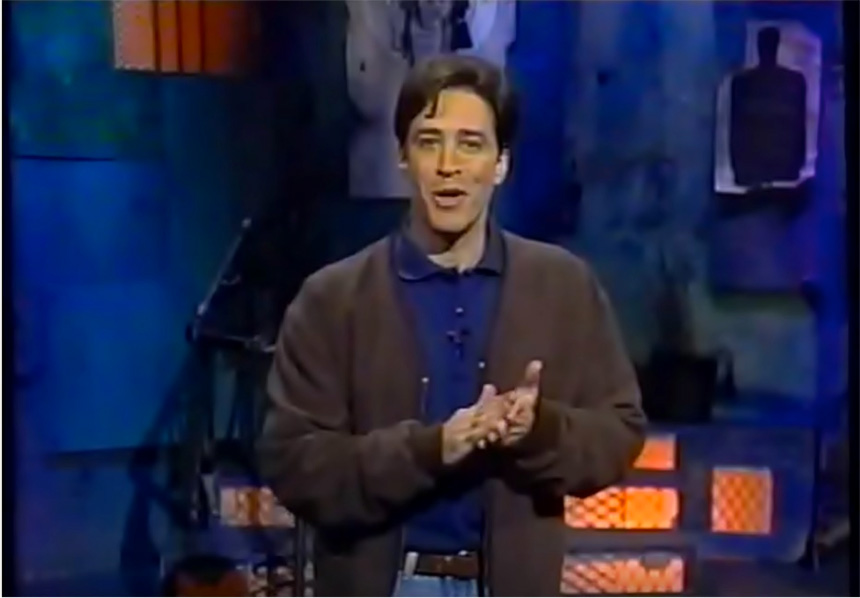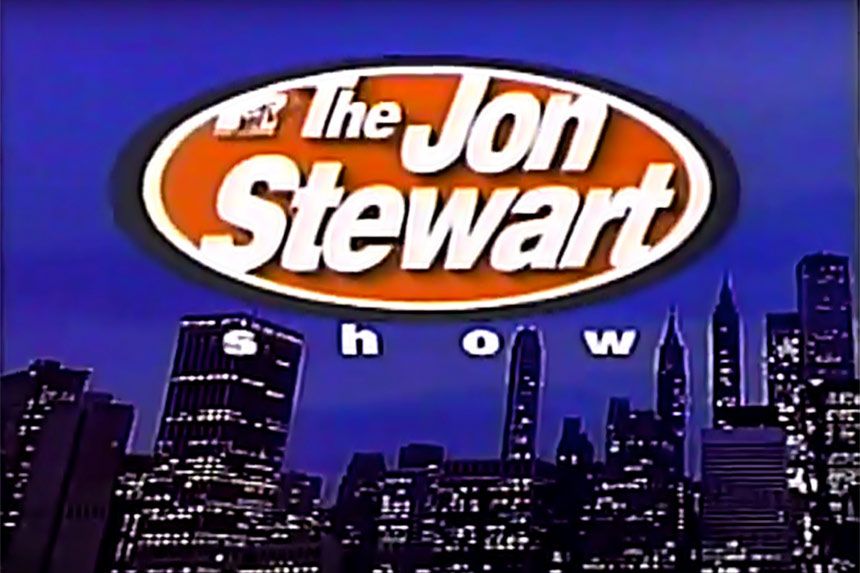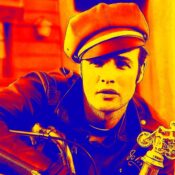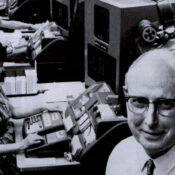Most people know Jon Stewart as the former host of The Daily Show, a program that made him the king of news satire. The Daily Show was a cultural phenomenon; at one point, Pew Research reported that 12% of Americans claimed to get their news from Stewart and the The Daily Show.
But Jon Stewart wasn’t always the master of late night. Twenty-five years earlier, he was a young comedian who caught a break hosting a talk show on MTV, becoming part of a movement that would shape film and television comedy for the next two decades and beyond.
In the 1980s, Stewart rose through the ranks as a comedian, eventually becoming co-host of Short Attention Span Theater on The Comedy Channel in 1990. While Stewart would co-host SAST with Patty Rosborough until 1993, he also began hosting a show on MTV called You Wrote It, You Watch It. This early stab at crowdsourced comedy featured skits submitted by viewers that would then be performed by the cast. Among the cast were all 11 members of the comedy troupe The State, including comedians Michael Ian Black and Joe Lo Truglio.

By 1993, MTV began developing its first talk show. Created by Stewart, The Jon Stewart Show arrived when MTV was the dynamic center of youth culture. The network had been instrumental in the spread of hip-hop to white audiences and the subsequent alternative music explosion of 1991 and 1992. According to Forbes, MTV made $400 million in revenue in 1992 alone while reaching more than 112 million homes around the world. A talk show on the network would have a huge reach and provide a playing venue for of-the-moment musical acts that frequently struggled to get booked on more mainstream outlets like The Tonight Show with Jay Leno.
Jon Stewart interviewed Conan O’Brien on the show in 1994.
Stewart’s 30-minute daily show followed a fairly traditional talk format. It featured a monologue, interaction with an announcer/sidekick (actor and comedian Howard Feller), skits, interviews with celebrities, and musical performances. The primary difference was Stewart himself; the then-30-year-old had a freewheeling style and readily connected with the teen and college audiences that MTV courted. As a viewer, you could believe that he actually listened to the musicians that appeared on the show, which included Marilyn Manson, Slayer, Guided by Voices, Notorious B.I.G., Body Count, Bad Religion, and Ol’ Dirty Bastard. The show quickly became the network’s second-highest rated series behind another 1993 debut, Beavis and Butt-Head.
That success led to Paramount Domestic Television, a corporate partner of MTV at the time, converting the show to a full hour and using it to replace the recently cancelled The Arsenio Hall Show in syndication for the 1994-1995 season. For the final half-hour episode on MTV, Stewart’s former Wrote/Watch castmates, the entirety of The State, appeared and destroyed the old set. This was in part a stunt to launch The State, a sketch series featuring the troupe that began airing on MTV in 1994.
The State debuted to decent ratings, but MTV saw the ratings increase as reruns of the original six episodes ran. The series capitalized on some initial negative reviews by incorporating them into ads for the show; the ironic approach drove further increases in viewership. By 1995, The State would make a deal to transition their series to CBS late nights.
Great Moments In . . . was a sketch typical of The State’s idea of turning a humorous premise on its head.
Unfortunately, neither the one-hour version of The Jon Stewart Show nor the CBS incarnation of The State succeeded. What worked for the ratings needs of a network like MTV did not equate to success in the mainstream broadcast market. On the final episode of Stewart, the guest was Stewart’s hero David Letterman, making a rare talk show appearance of his own. Letterman praised Stewart’s work and pointed out that being cancelled was not the same thing as failing.
Letterman’s appearance on the final episode of The Jon Stewart Show in 1995.
In the aftermath of the cancellations, a funny thing happened. Stewart continued working steadily in comedy and film until he was tapped to replace the departing Craig Kilborn on The Daily Show in 1999. Stewart’s arrival sparked a creative rebirth for the show, which is produced by Letterman’s Worldwide Pants company. Stewart hosted the show until 2015, after which he stepped down to pursue other projects.
As for The State, their members spread out into a number of television and film projects. Sometimes acting, sometimes writing and directing, and sometimes producing, the members in various combinations have created or contributed to programs and films like Viva Variety, Reno 911!, Wet Hot American Summer, and the Night at the Museum franchise. As actors, the 11 members of The State remain consistent presences in television, film, and voice acting.
Looking back, Stewart and friends captured a moment when the style of television comedy was changing. They proved it could be absurdist and topical at the same time, occasionally taking on serious subjects in the silliest ways. Like Letterman was to Stewart, they’ve become the mentors of next generation talents like John Oliver, Samantha Bee, and Trevor Noah. Their stories remain a solid reminder that even if one attempt fails, somebody else will probably get the joke.
Become a Saturday Evening Post member and enjoy unlimited access. Subscribe now



